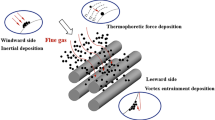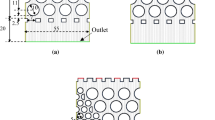Abstract
One of the ways to mitigate fouling and slagging in downstream sections of boilers, power plants, and gas turbines employing coal combustion is to coat the boiler tubes with low surface energy materials. Such a coating not only reduces the surface energy but can potentially offer a rough surface as well. Hence, the simultaneous effects of surface energy and roughness on fly ash deposition need to be understood. Slag-layer deposition involves drop dynamics associated with arrival of molten ash droplets. While recoiling after reaching maximum spread diameter, the drop may bounce or stick depending on the retraction energy. Bouncing potential of the recoiling droplet decides its fate—to stick or to bounce. In order to quantify the bouncing potential, the spread ratio—maximum spread diameter to initial drop diameter—needs to be evaluated. In this study, models are presented to calculate the spread ratio and bouncing potential of impacting drops on rough surfaces; these incorporate the phenomenon of air/gas pockets present beneath the spreading and recoiling splat. The velocity profiles of the spreading droplet, derived by solving axisymmetric creeping flow, are employed to theoretically estimate the dissipation energy while spreading. The predictions of the proposed spread ratio model—free from fitting parameters—are compared with experimental data in literature and are shown to be within ±5 % of the reported values. With the capability to predict whether the droplet bounces or sticks, the bouncing potential model is exploited to suggest choices of roughness and surface energy to mitigate slagging deposits.




Similar content being viewed by others
References
Balakrishnan, S., Nagarajan, R.: Fouling intensity of three Indian coals. Coal Combust. Gasif. Prod. 5, 31–38 (2013)
Ambedkar, B., Chintala, T.N., Nagarajan, R., Jayanti, S.: Feasibility of using Ultrasound-assisted process for sulphur and ash removal from coal. Chem. Eng. Process. Process Intensif. 50, 236–246 (2011)
Kyi, S., Chadwick, B.L.: Screening of potential mineral additives for use as fouling preventatives in Victorian brown coal combustion. Fuel 78, 845–855 (1999)
Kousaalya, A.B.: Development and characterization of precursors derived Si-O-C and Si-B-C-N ceramic materials. M.S. Thesis, IIT – Madras (2013)
Ni, J., Yu, G., Guo, Q., Zhou, Z., Wang, F.: Submodel for predicting slag deposition formation in slagging gasification systems. Energy Fuels 25, 1004–1009 (2011)
Rein, W.: Phenomena of liquid drop impact on solid and liquid surface. Fluid Dyn. Res. 12, 61–93 (1993)
Yarin, A.L.: Drop impact dynamics: splashing, spreading, receding, bouncing. Annu. Rev. Fluid Mech. 38, 159–192 (2006)
Pasandideh-Fard, M., Qiao, Y.M., Chandra, S., Mostaghimi, J.: Capillary effects during droplet impact on a solid surface. Phys. Fluids 8, 650–659 (1996)
Chandra, S., Avedision, C.: On the collision of a droplet with a solid surface. Proc. R. Soc. Lond. A. 432, 13–41 (1991)
Mao, T., Kuhn, D.C.S., Tran, H.: Spread and rebound of liquid droplets upon impact on flat surfaces. AIChEJ 43, 2169–2179 (1997)
Hsiao, W.K., Chun, J.H., Saka, N.: The effect of wetting and surface roughness on liquid metal droplet bouncing. J. Manuf. Sci. Eng. 131, 21010-1–21010-8 (2009)
Feng, Z.G., Domaszewski, M., Montavon, G., Coddet, C.: Finite element analysis of effect of substrate surface roughness on liquid droplet impact and flattening process. ASME J. Therm. Spray Technol. 11, 62–68 (2002)
Liu, J., Franco, W., Aguilar, G.: Effect of surface roughness on single cryogen droplet spreading. J. Fluids Eng. 130, 041402-1–041402-9 (2008)
Lee, J.B., Lee, S.H.: Dynamic wetting and spreading characteristic of a liquid droplet impinging on hydrophobic textured surfaces. Langmuir 27, 6565–6573 (2011)
Gong, S.C.: Spreading of droplets impacting on smooth solid surface. Jpn. J. Appl. Phys. 44, 3323–3324 (2005)
Papanastasiou, T.C., Georgiou, G., Alexandrou, A.N.: Viscous fluid flow. CRC Press, Boca Raton (2000)
Prasher, R.S.: Surface chemistry and characteristics based model for the thermal contact resistance of fluidic interstitial thermal interface materials. ASME J. Heat Transf. 123, 969–975 (2001)
Lagubeau, G., Fontelos, M.A., Josserand, C., Maurel, A., Pagneux, V., Petitjeans, P.: Spreading dynamics of drop impacts. J. Fluid Mech. 713, 50–60 (2012)
Kim, H.Y., Chun, J.H.: The recoiling of liquid droplets upon collision with solid surfaces. Phys. Fluids 13, 643–659 (2001)
Attane, P., Girard, F., Morin, V.: An energy balance approach of the dynamics of drop impact on a solid surface. Phys. Fluids 19, 012101-1–012101-17 (2007)
Culick, F.E.: Comments on a ruptured soap film. J. Appl. Phys. 31, 1128–1129 (1960)
Bäumchen, O., Lessel, M., Fetzer, R., Seemann, R., Jacobs, K.J.: Sliding fluids: dewetting experiments reveal the solid/liquid boundary condition. Phys. Conf. Ser. 216, 1–7 (2010)
Ranz, W.E.: Some experiments on the dynamics of liquid films. J. Appl. Phys. 30, 1950–1955 (1959)
Bird, R.B., Stewart, W.E., Lightfoot, E.N.: Transport phenomena. Wiley, Delhi (2002)
Author information
Authors and Affiliations
Corresponding author
Rights and permissions
About this article
Cite this article
Balakrishnan, S., Nagarajan, R. Effect of surface roughness and surface energy on molten fly ash deposition. Int J Adv Eng Sci Appl Math 6, 41–48 (2014). https://doi.org/10.1007/s12572-014-0108-8
Published:
Issue Date:
DOI: https://doi.org/10.1007/s12572-014-0108-8




